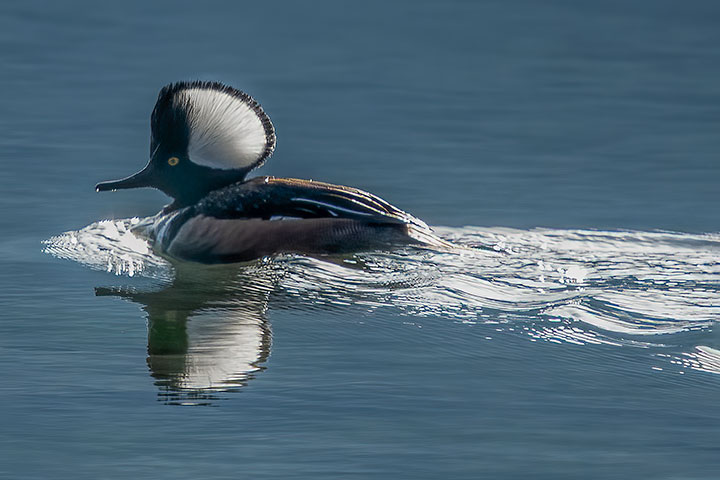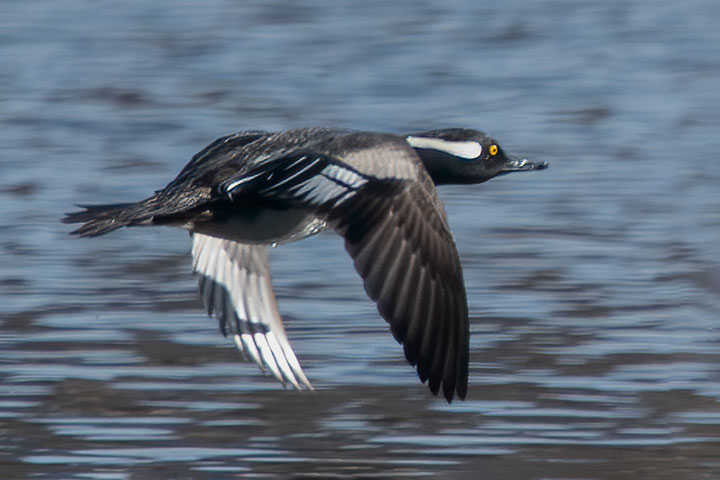Much of bird watching involves creature identification, along with tracking seasonal migration.
However, this posting is about neither of these; rather, it treats obscure behaviours of a duck, the Hooded Merganser. The issue is that of the duck optimizing travel so as to minimize the energy required. As do many waterfowl, this duck both swims and flies. So, an example will be chosen from each mode of travel by using two pictures taken about an hour apart.
Swimming
Creatures that travel over the surface of water (ducks, otters, kayaks, supertankers) and are supported by buoyancy (so, are not planing) leave waves in their wake. It takes energy to create a wake and this is energy the creature must supply. Creating a wake requires work and so is a drag on travel.
The wake has a couple of components: divergent waves and transverse waves. The divergent waves spread laterally; the transverse waves lie at right angles to the direction of travel and are left behind. The transverse waves are the subject of this discussion.
Transverse waves are generated at two locations: the bow (front) and the stern (back) of the duck. As they superimpose in the wake, these two waves can either interfere constructively to produce large waves (producing a maximal drag), or interfere destructively to cancel one another (producing a minimal drag). Which happens depends upon the speed of the duck and so is under the duck’s control. Of course, the Hooded Merganser does not calculate this, but rather senses the effort it takes to move and so travels at a speed that minimizes its wave drag.
While divergent waves remain, the hoodie’s transverse waves have been substantially canceled.

Flying
Flight involves two major forms of drag: parasitic and induced.
Parasitic drag results from energy lost to turbulent eddies shed by objects moving rapidly through the air, such as a runner, automobile, train, bird, or aircraft. Parasitic drag increases as the square of the speed.
Induced drag is equal to the force required to provide lift and results from the change in direction of air flow around a wing which supports the weight of the flying object. Induced drag changes inversely with the square of the speed.
So, one type of drag increases with flight speed, the other decreases with flight speed. At some speed, the sum of the two drags has a minimum value: an optimal flight speed. Birds, including Hooded Mergansers, tend to fly at (or near) this optimal speed because it minimizes the energy required for flying.
However, the Hooded Merganser has an additional consideration: its hood (crest). Parasitic drag is proportional to the forward-facing cross-sectional area of the bird, and that area would include the hood if the bird were to keep it erected, so the bird collapses its hood when flying.
The hoodie collapses its hood (see previous picture) to minimize parasitic drag when flying.

While both of these behaviours — minimizing wave drag when swimming, minimizing parasitic drag when flying — easily pass unnoticed; each is crucial to the duck.

This is an nteresting perspective for me as both a pilot and sailor. Thanks! I often watch the Canada Geese on our small lake and marvel at their flying skills. From hatching out to solo flight in only six months.
Very interesting information and observation. Love reading your posts. Living in North Carolina I learn so much about differences in nature between your area and here. Thank you for providing beautiful pictures and informative writings.
Thanks Alistair. I always learn something. I also noted that your second photo has the shadow of the duck’s head on the wing.
This was fascinating to a terrible swimmer who has never mastered the crawl stroke (thrashing about producing a ton of divergent and lateral waves that leave me completely exhausted). I’ve settled on a gentle breaststroke that gets me across the lake.